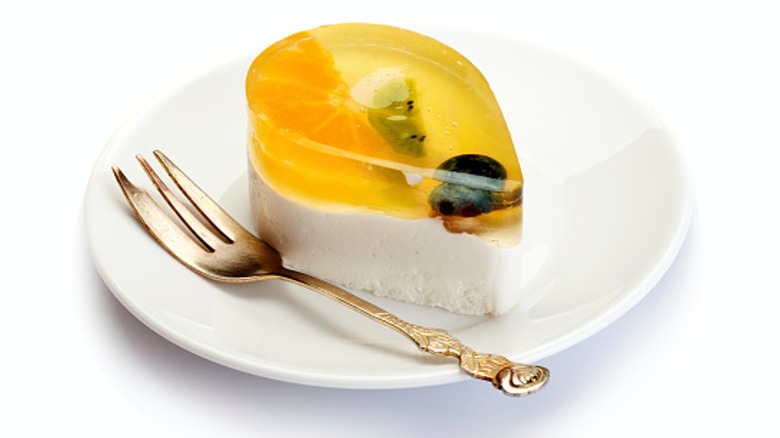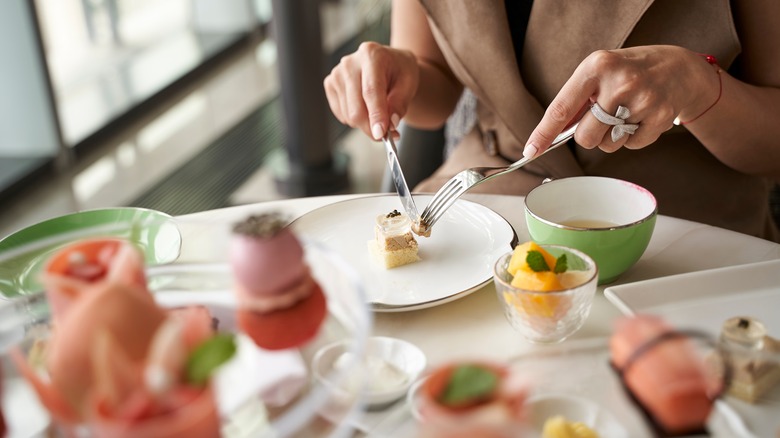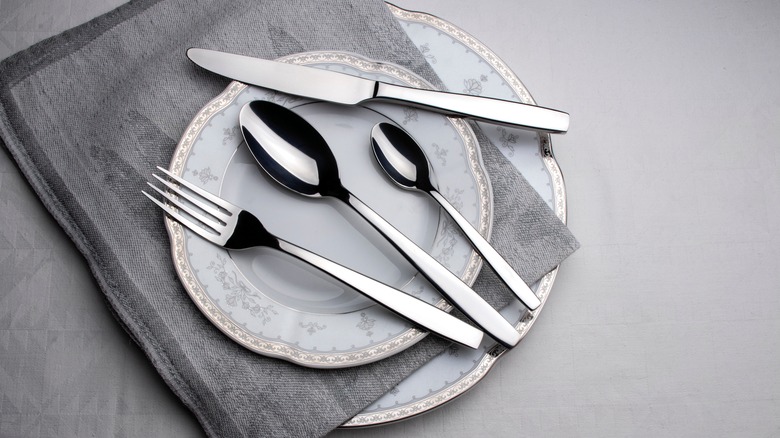Here's Why Cake Forks Have Those Mysterious Notches
The fork: A seemingly simple instrument with a complex rulebook. For a utensil to be classified as a fork, it must have between two and four prongs, also known as tines. There are over 35 types of forks that all have very specific uses, from a thinly shaped salad fork to a fork specifically for fondue. One of the forks you might think is chipped and broken is actually the cake fork. Also known as a pastry fork, this interesting gadget has three prongs, with a wider third prong and a notch on the outermost one. Unsurprisingly, not many know what exactly this chipped fork is used for.
The Sojourner Truth African Heritage Museum reported that the invention of the pastry fork dates back to 1892 and was created by African-American inventor, Anna M. Mangin. Back then, she invented it with the intent to easily mix dough, pie crusts, and even beat eggs without getting sticky ingredients all over her hands. Over time, the pastry fork continues to be used as a baking tool, as well as a handy way to enjoy various pastries. According to Taste of Home, pastry forks are supposed to do the work of both a fork and a knife. With the wider tine on one side, you can more easily cut into pastries without dirtying another utensil and save your energy for enjoying your dessert. The notch on the outer tine may look like a mistake, but it is purposely designed that way to provide an easier cut into desserts.
How to properly use a cake fork
Proper fork etiquette reminds us that using a fork for the incorrect purpose is a serious no-no. Cake forks, or pastry forks, will be placed on the inside of your place setting, closest to your dishes. Table rules say to use cutlery from the outside in, saving your pastry fork for last. These fancy chipped forks are intended to be used for cakes, pastries, and other desserts that need to be carved into before taking a bite. Some chipped tine forks can be used for deboning fish or slicing into tough meats, but it's recommended not to use the same fork for both your entree and after-dinner sweet treat. No one wants fish remains contaminating their slice of cheesecake.
Sadly for the 10% of the population who are left-handed, pastry forks were not exactly designed with you in mind. The widest tine is placed on the outer right-hand side, allowing right-handed people to easily cut through pastries, while their left-handed friends hold the cutlery on the opposite side. But just like a pair of scissors, writing on a whiteboard, and just about everything else, lefties can still figure out a way to make pastry forks work for them — most likely by turning the fork around and using the wide tine upside down.
The history of cutlery is a long and (surprisingly) interesting one
While the fork dominates the world of cutlery in this day and age, its neighbors the spoon and knife have been around much longer. As humans found new ways to craft tools, knives were the first to be utilized for cutting and preparing food, followed closely by spoons. The exact origin of the fork is not agreed upon by historians, although many attribute China as the first to craft pronged utensils for cooking around 2400 B.C. Versions of the fork that were used at the table came much later, and it wasn't until around the 7th century that the pointy utensil became widely used alongside the spoon and knife.
During a time when a majority of people still ate food with their hands, early versions of forks were criticized as being "too feminine," as fork users utilized this new invention in an attempt to be less dirty while eating. Other critics of the pronged device believed forks were satanic in nature, too closely resembling pitchforks that appeared threatening to some cultures and religions. For the most part, society has moved past their uneasiness around the fork, and now uses the tool for a wide range of purposes. Whether you're reaching for a four-prong dinner fork or a three-prong pastry fork, keep in mind its long history and its proper uses before you dig in.


